JEEP WRANGLER UNLIMITED 2020 Owner handbook (in English)
Manufacturer: JEEP, Model Year: 2020, Model line: WRANGLER UNLIMITED, Model: JEEP WRANGLER UNLIMITED 2020Pages: 330, PDF Size: 9.16 MB
Page 221 of 330
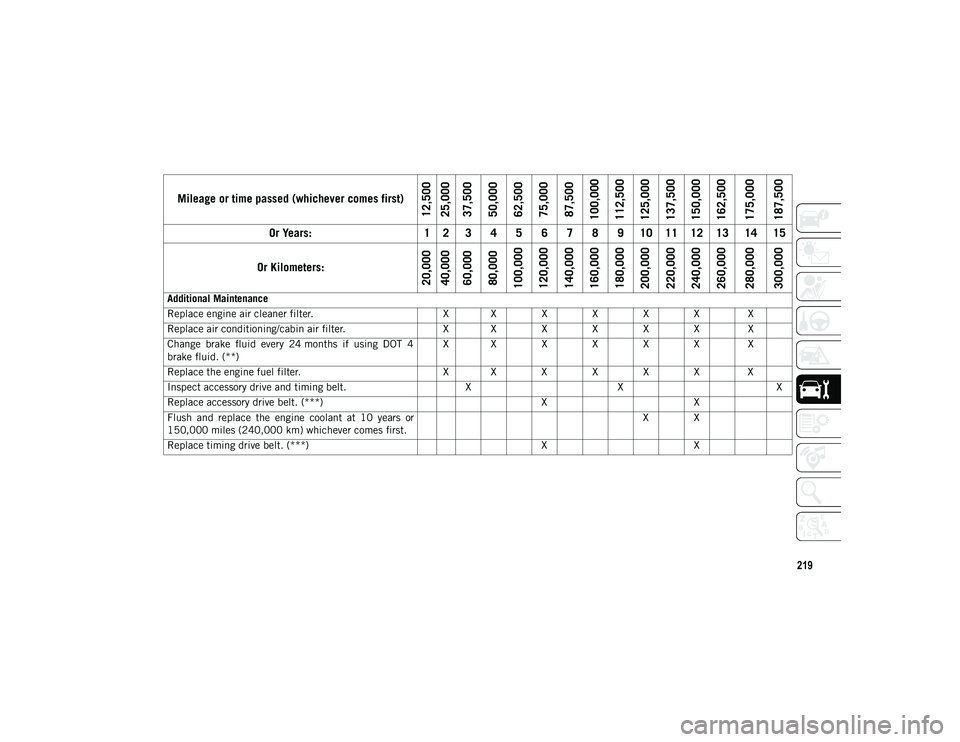
219
Additional Maintenance
Replace engine air cleaner filter.X X X X X X X
Replace air conditioning/cabin air filter. X X X X X X X
Change brake fluid every 24 months if using DOT 4
brake fluid. (**) X X X X X X X
Replace the engine fuel filter. X X X X X X X
Inspect accessory drive and timing belt. XX X
Replace accessory drive belt. (***) XX
Flush and replace the engine coolant at 10 years or
150,000 miles (240,000 km) whichever comes first. X X
Replace timing drive belt. (***) XX
Mileage or time passed (whichever comes first)
12,500
25,000
37,500
50,000
62,500
75,000
87,500
100,000
112,500
125,000
137,500
150,000
162,500
175,000
187,500
Or Years: 1 2 3 4 5 6 7 8 9 10 11 12 13 14 15
Or Kilometers:
20,000
40,000
60,000
80,000
100,000
120,000
140,000
160,000
180,000
200,000
220,000
240,000
260,000
280,000
300,000
2020_JEEP_JL_WRANGLER_UG_RHD_UK.book Page 219
Page 222 of 330
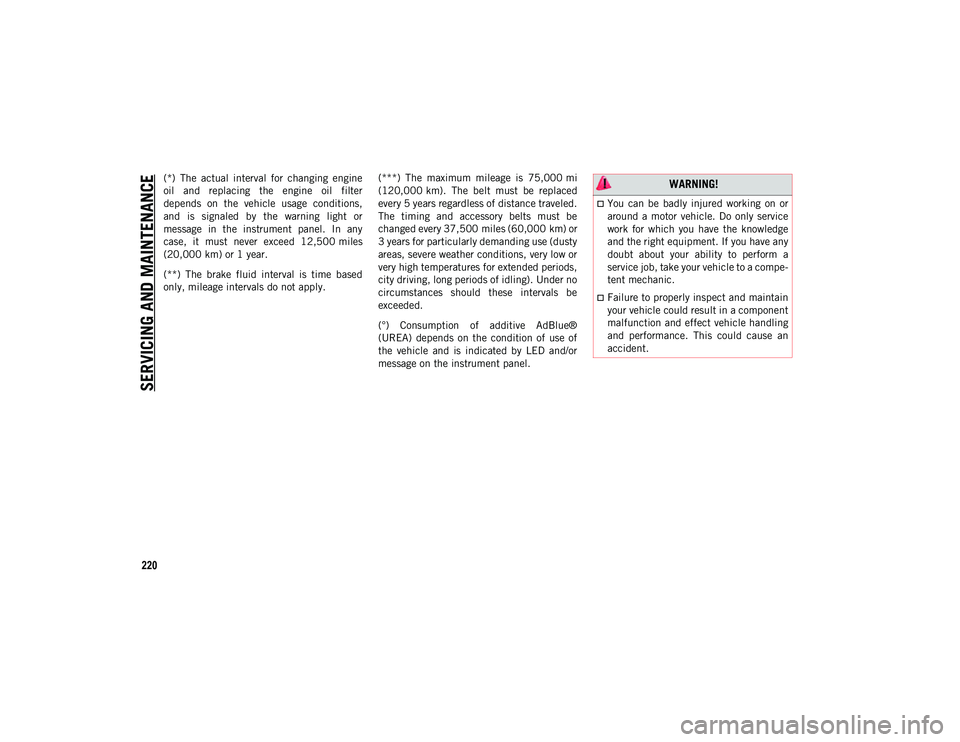
SERVICING AND MAINTENANCE
220
(*) The actual interval for changing engine
oil and replacing the engine oil filter
depends on the vehicle usage conditions,
and is signaled by the warning light or
message in the instrument panel. In any
case, it must never exceed 12,500 miles
(20,000 km) or 1 year.
(**) The brake fluid interval is time based
only, mileage intervals do not apply.(***) The maximum mileage is 75,000 mi
(120,000 km). The belt must be replaced
every 5 years regardless of distance traveled.
The timing and accessory belts must be
changed every 37,500 miles (60,000 km) or
3 years for particularly demanding use (dusty
areas, severe weather conditions, very low or
very high temperatures for extended periods,
city driving, long periods of idling). Under no
circumstances should these intervals be
exceeded.
(°) Consumption of additive AdBlue®
(UREA) depends on the condition of use of
the vehicle and is indicated by LED and/or
message on the instrument panel. WARNING!
You can be badly injured working on or
around a motor vehicle. Do only service
work for which you have the knowledge
and the right equipment. If you have any
doubt about your ability to perform a
service job, take your vehicle to a compe-
tent mechanic.
Failure to properly inspect and maintain
your vehicle could result in a component
malfunction and effect vehicle handling
and performance. This could cause an
accident.
2020_JEEP_JL_WRANGLER_UG_RHD_UK.book Page 220
Page 223 of 330
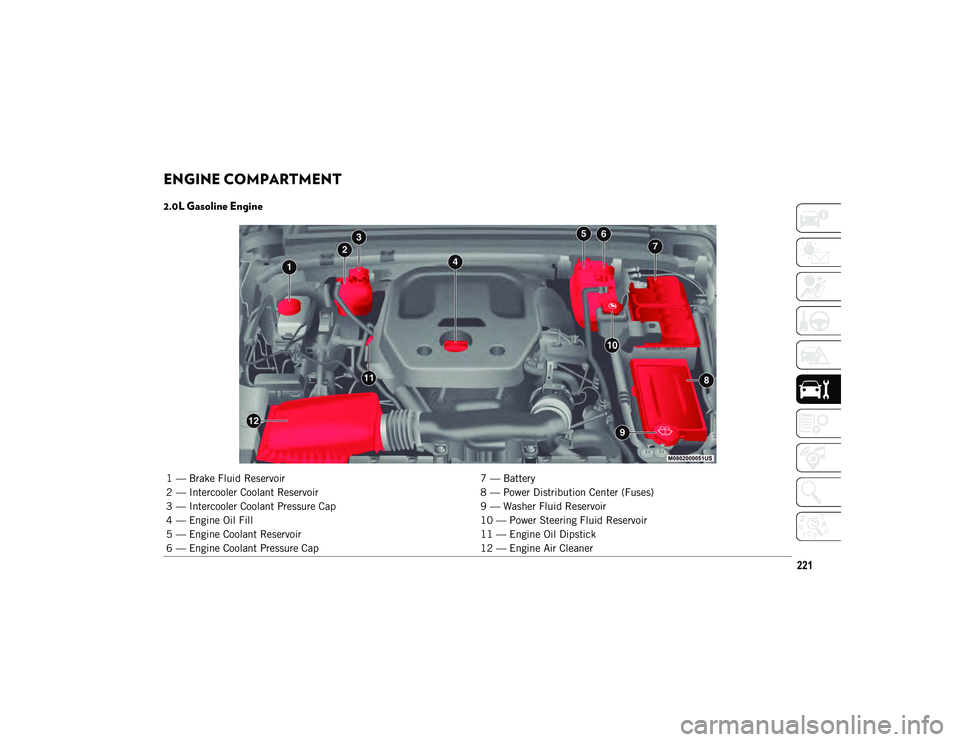
221
ENGINE COMPARTMENT
2.0L Gasoline Engine
1 — Brake Fluid Reservoir7 — Battery
2 — Intercooler Coolant Reservoir 8 — Power Distribution Center (Fuses)
3 — Intercooler Coolant Pressure Cap 9 — Washer Fluid Reservoir
4 — Engine Oil Fill 10 — Power Steering Fluid Reservoir
5 — Engine Coolant Reservoir 11 — Engine Oil Dipstick
6 — Engine Coolant Pressure Cap 12 — Engine Air Cleaner
2020_JEEP_JL_WRANGLER_UG_RHD_UK.book Page 221
Page 224 of 330
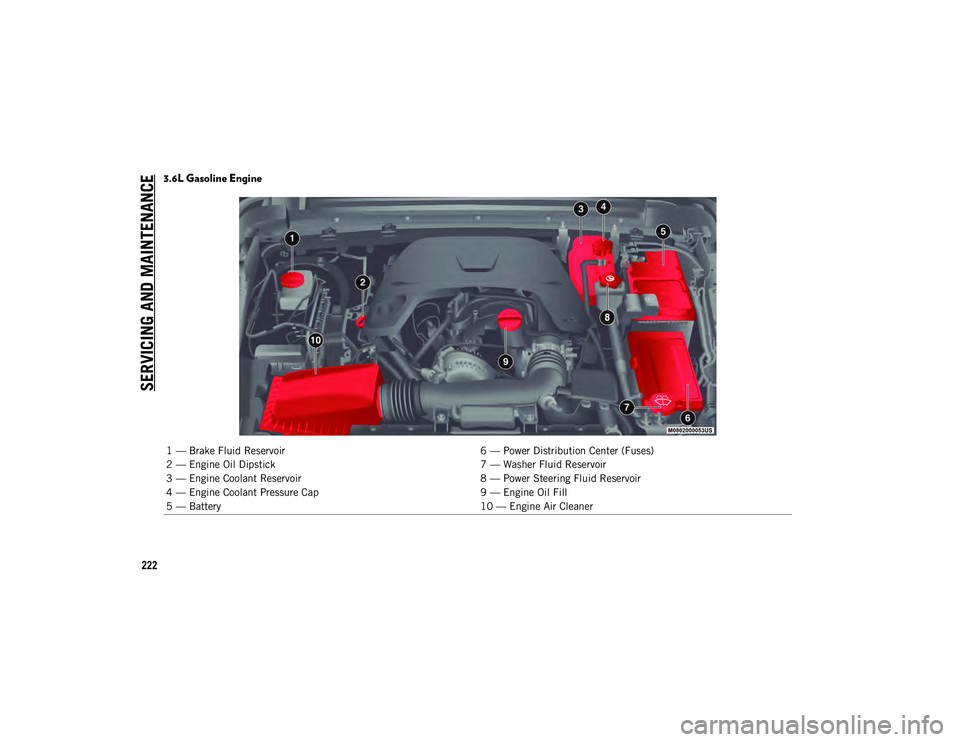
SERVICING AND MAINTENANCE
222
3.6L Gasoline Engine
1 — Brake Fluid Reservoir6 — Power Distribution Center (Fuses)
2 — Engine Oil Dipstick 7 — Washer Fluid Reservoir
3 — Engine Coolant Reservoir 8 — Power Steering Fluid Reservoir
4 — Engine Coolant Pressure Cap 9 — Engine Oil Fill
5 — Battery 10 — Engine Air Cleaner
2020_JEEP_JL_WRANGLER_UG_RHD_UK.book Page 222
Page 225 of 330
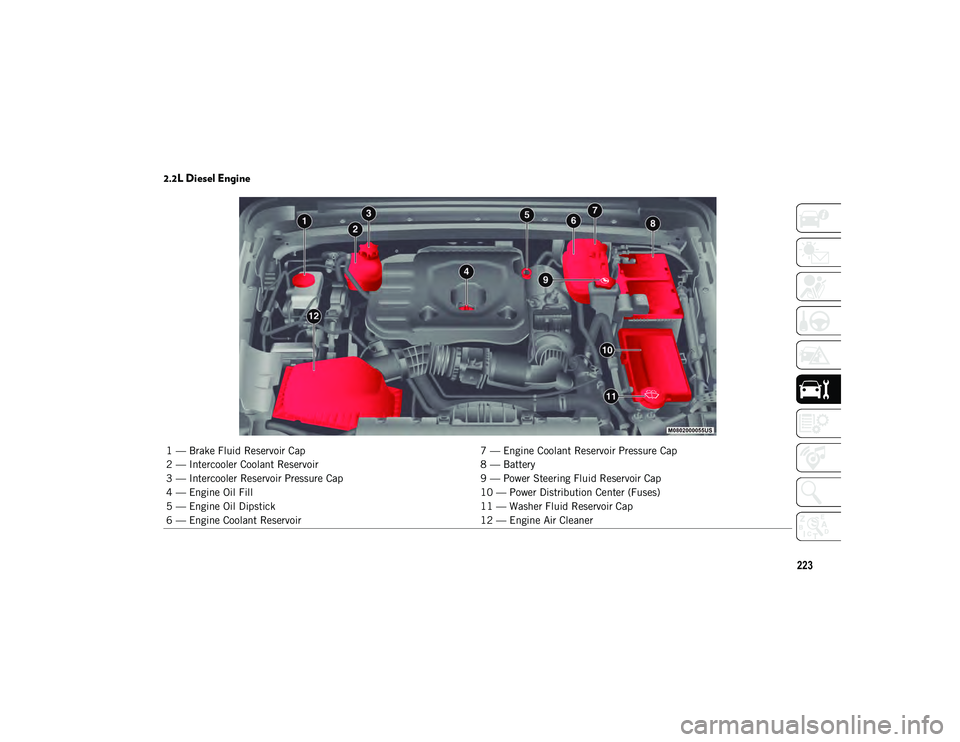
223
2.2L Diesel Engine
1 — Brake Fluid Reservoir Cap7 — Engine Coolant Reservoir Pressure Cap
2 — Intercooler Coolant Reservoir 8 — Battery
3 — Intercooler Reservoir Pressure Cap 9 — Power Steering Fluid Reservoir Cap
4 — Engine Oil Fill 10 — Power Distribution Center (Fuses)
5 — Engine Oil Dipstick 11 — Washer Fluid Reservoir Cap
6 — Engine Coolant Reservoir 12 — Engine Air Cleaner
2020_JEEP_JL_WRANGLER_UG_RHD_UK.book Page 223
Page 226 of 330
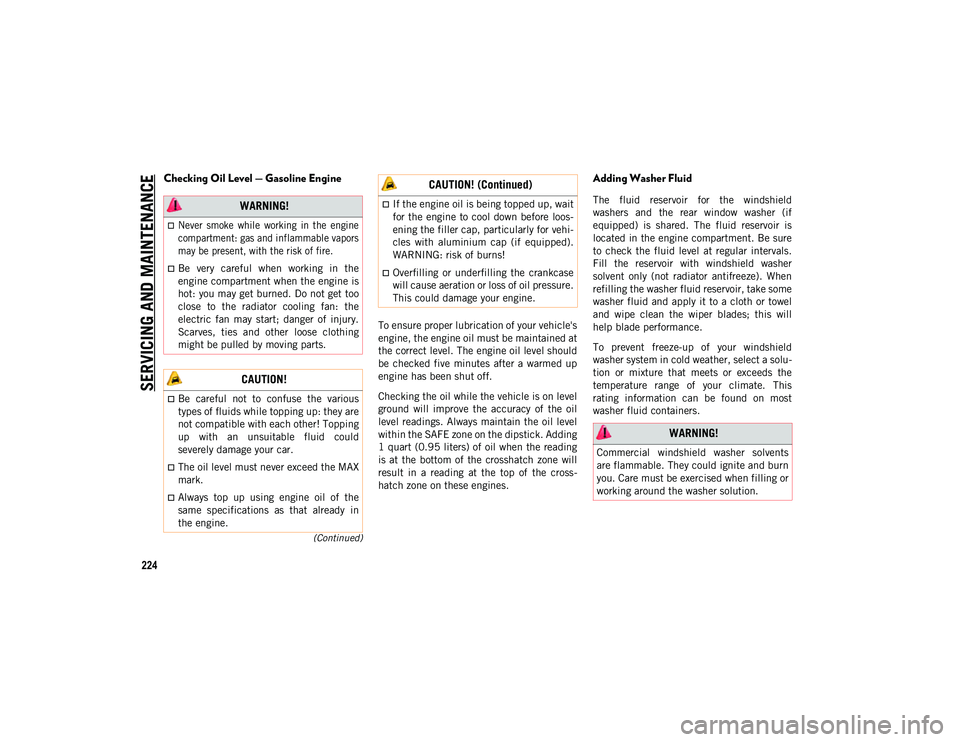
SERVICING AND MAINTENANCE
224
(Continued)
Checking Oil Level — Gasoline Engine
To ensure proper lubrication of your vehicle's
engine, the engine oil must be maintained at
the correct level. The engine oil level should
be checked five minutes after a warmed up
engine has been shut off.
Checking the oil while the vehicle is on level
ground will improve the accuracy of the oil
level readings. Always maintain the oil level
within the SAFE zone on the dipstick. Adding
1 quart (0.95 liters) of oil when the reading
is at the bottom of the crosshatch zone will
result in a reading at the top of the cross-
hatch zone on these engines.
Adding Washer Fluid
The fluid reservoir for the windshield
washers and the rear window washer (if
equipped) is shared. The fluid reservoir is
located in the engine compartment. Be sure
to check the fluid level at regular intervals.
Fill the reservoir with windshield washer
solvent only (not radiator antifreeze). When
refilling the washer fluid reservoir, take some
washer fluid and apply it to a cloth or towel
and wipe clean the wiper blades; this will
help blade performance.
To prevent freeze-up of your windshield
washer system in cold weather, select a solu -
tion or mixture that meets or exceeds the
temperature range of your climate. This
rating information can be found on most
washer fluid containers. WARNING!
Never smoke while working in the engine
compartment: gas and inflammable vapors
may be present, with the risk of fire.
Be very careful when working in the
engine compartment when the engine is
hot: you may get burned. Do not get too
close to the radiator cooling fan: the
electric fan may start; danger of injury.
Scarves, ties and other loose clothing
might be pulled by moving parts.
CAUTION!
Be careful not to confuse the various
types of fluids while topping up: they are
not compatible with each other! Topping
up with an unsuitable fluid could
severely damage your car.
The oil level must never exceed the MAX
mark.
Always top up using engine oil of the
same specifications as that already in
the engine.
If the engine oil is being topped up, wait
for the engine to cool down before loos-
ening the filler cap, particularly for vehi -
cles with aluminium cap (if equipped).
WARNING: risk of burns!
Overfilling or underfilling the crankcase
will cause aeration or loss of oil pressure.
This could damage your engine.
CAUTION! (Continued)
WARNING!
Commercial windshield washer solvents
are flammable. They could ignite and burn
you. Care must be exercised when filling or
working around the washer solution.
2020_JEEP_JL_WRANGLER_UG_RHD_UK.book Page 224
Page 227 of 330
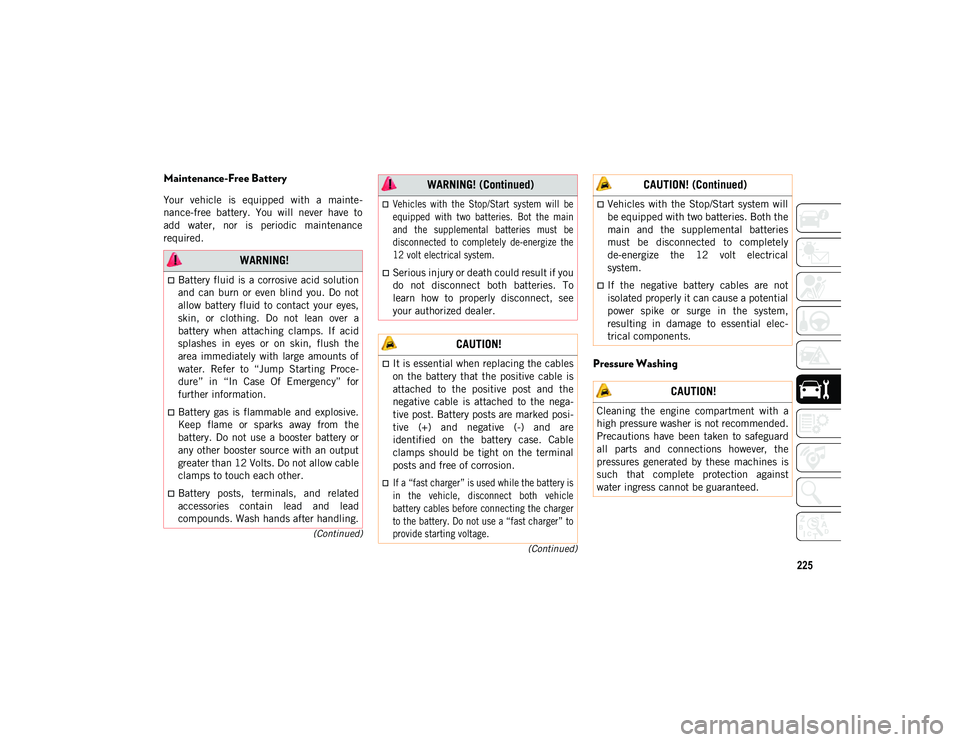
225
(Continued)
(Continued)
Maintenance-Free Battery
Your vehicle is equipped with a mainte
-
nance-free battery. You will never have to
add water, nor is periodic maintenance
required.
Pressure Washing
WARNING!
Battery fluid is a corrosive acid solution
and can burn or even blind you. Do not
allow battery fluid to contact your eyes,
skin, or clothing. Do not lean over a
battery when attaching clamps. If acid
splashes in eyes or on skin, flush the
area immediately with large amounts of
water. Refer to “Jump Starting Proce-
dure” in “In Case Of Emergency” for
further information.
Battery gas is flammable and explosive.
Keep flame or sparks away from the
battery. Do not use a booster battery or
any other booster source with an output
greater than 12 Volts. Do not allow cable
clamps to touch each other.
Battery posts, terminals, and related
accessories contain lead and lead
compounds. Wash hands after handling.
Vehicles with the Stop/Start system will be
equipped with two batteries. Bot the main
and the supplemental batteries must be
disconnected to completely de-energize the
12 volt electrical system.
Serious injury or death could result if you
do not disconnect both batteries. To
learn how to properly disconnect, see
your authorized dealer.
CAUTION!
It is essential when replacing the cables
on the battery that the positive cable is
attached to the positive post and the
negative cable is attached to the nega-
tive post. Battery posts are marked posi -
tive (+) and negative (-) and are
identified on the battery case. Cable
clamps should be tight on the terminal
posts and free of corrosion.
If a “fast charger” is used while the battery is
in the vehicle, disconnect both vehicle
battery cables before connecting the charger
to the battery. Do not use a “fast charger” to
provide starting voltage.
WARNING! (Continued)
Vehicles with the Stop/Start system will
be equipped with two batteries. Both the
main and the supplemental batteries
must be disconnected to completely
de-energize the 12 volt electrical
system.
If the negative battery cables are not
isolated properly it can cause a potential
power spike or surge in the system,
resulting in damage to essential elec-
trical components.
CAUTION!
Cleaning the engine compartment with a
high pressure washer is not recommended.
Precautions have been taken to safeguard
all parts and connections however, the
pressures generated by these machines is
such that complete protection against
water ingress cannot be guaranteed.
CAUTION! (Continued)
2020_JEEP_JL_WRANGLER_UG_RHD_UK.book Page 225
Page 228 of 330
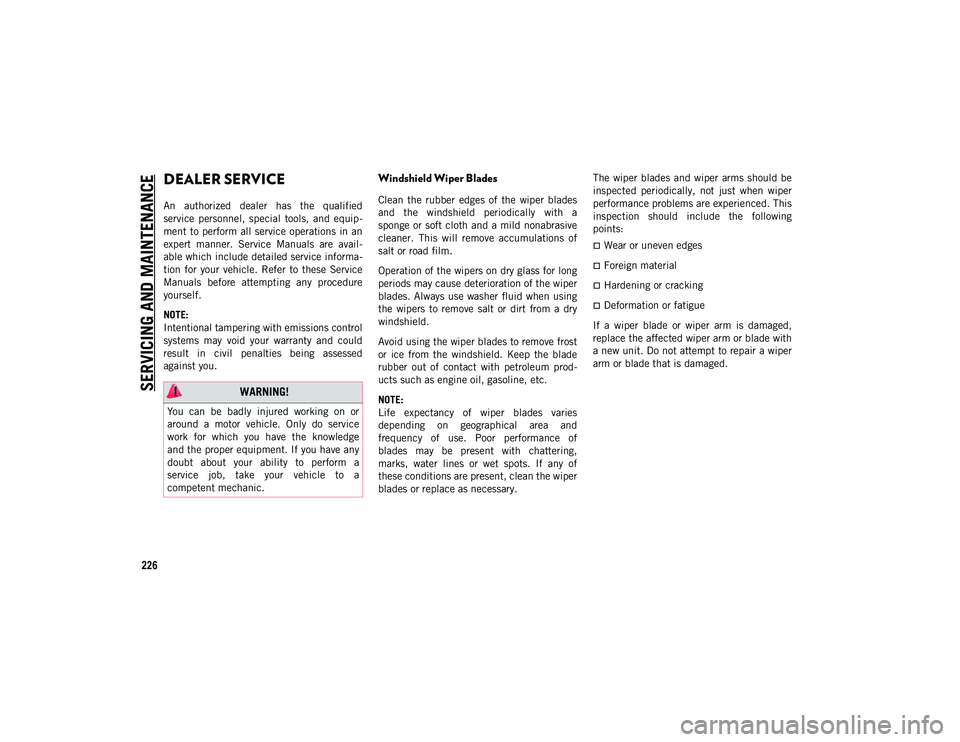
SERVICING AND MAINTENANCE
226
DEALER SERVICE
An authorized dealer has the qualified
service personnel, special tools, and equip-
ment to perform all service operations in an
expert manner. Service Manuals are avail -
able which include detailed service informa -
tion for your vehicle. Refer to these Service
Manuals before attempting any procedure
yourself.
NOTE:
Intentional tampering with emissions control
systems may void your warranty and could
result in civil penalties being assessed
against you.
Windshield Wiper Blades
Clean the rubber edges of the wiper blades
and the windshield periodically with a
sponge or soft cloth and a mild nonabrasive
cleaner. This will remove accumulations of
salt or road film.
Operation of the wipers on dry glass for long
periods may cause deterioration of the wiper
blades. Always use washer fluid when using
the wipers to remove salt or dirt from a dry
windshield.
Avoid using the wiper blades to remove frost
or ice from the windshield. Keep the blade
rubber out of contact with petroleum prod -
ucts such as engine oil, gasoline, etc.
NOTE:
Life expectancy of wiper blades varies
depending on geographical area and
frequency of use. Poor performance of
blades may be present with chattering,
marks, water lines or wet spots. If any of
these conditions are present, clean the wiper
blades or replace as necessary. The wiper blades and wiper arms should be
inspected periodically, not just when wiper
performance problems are experienced. This
inspection should include the following
points:
Wear or uneven edges
Foreign material
Hardening or cracking
Deformation or fatigue
If a wiper blade or wiper arm is damaged,
replace the affected wiper arm or blade with
a new unit. Do not attempt to repair a wiper
arm or blade that is damaged.
WARNING!
You can be badly injured working on or
around a motor vehicle. Only do service
work for which you have the knowledge
and the proper equipment. If you have any
doubt about your ability to perform a
service job, take your vehicle to a
competent mechanic.
2020_JEEP_JL_WRANGLER_UG_RHD_UK.book Page 226
Page 229 of 330
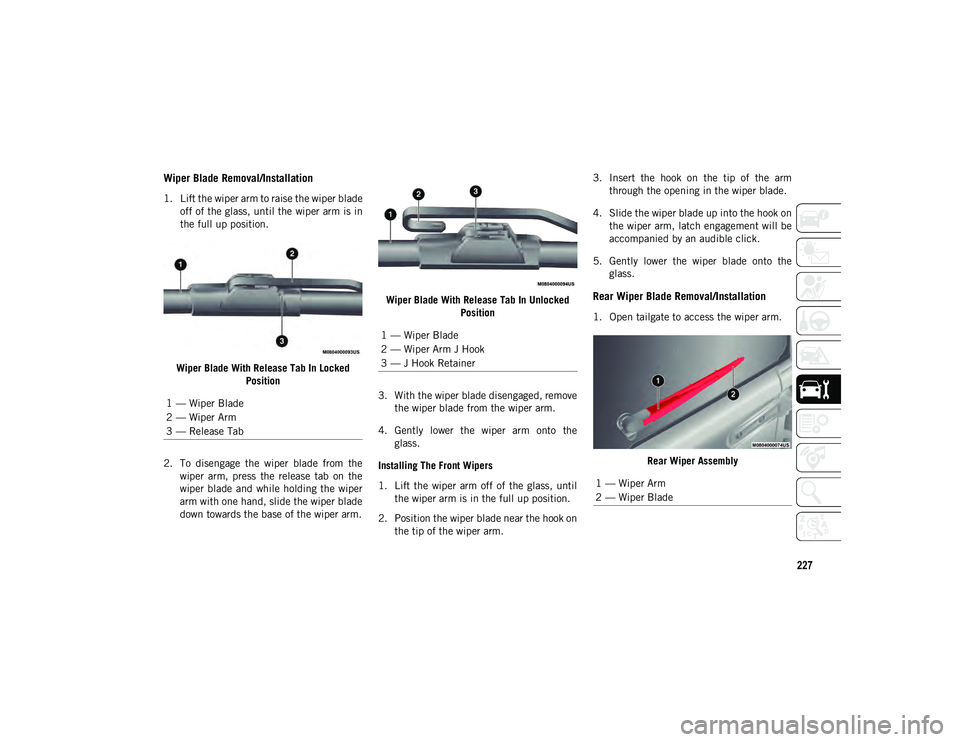
227
Wiper Blade Removal/Installation
1. Lift the wiper arm to raise the wiper bladeoff of the glass, until the wiper arm is in
the full up position.
Wiper Blade With Release Tab In Locked Position
2. To disengage the wiper blade from the wiper arm, press the release tab on the
wiper blade and while holding the wiper
arm with one hand, slide the wiper blade
down towards the base of the wiper arm. Wiper Blade With Release Tab In Unlocked
Position
3. With the wiper blade disengaged, remove the wiper blade from the wiper arm.
4. Gently lower the wiper arm onto the glass.
Installing The Front Wipers
1. Lift the wiper arm off of the glass, until the wiper arm is in the full up position.
2. Position the wiper blade near the hook on the tip of the wiper arm. 3. Insert the hook on the tip of the arm
through the opening in the wiper blade.
4. Slide the wiper blade up into the hook on the wiper arm, latch engagement will be
accompanied by an audible click.
5. Gently lower the wiper blade onto the glass.
Rear Wiper Blade Removal/Installation
1. Open tailgate to access the wiper arm.
Rear Wiper Assembly
1 — Wiper Blade
2 — Wiper Arm
3 — Release Tab
1 — Wiper Blade
2 — Wiper Arm J Hook
3 — J Hook Retainer
1 — Wiper Arm
2 — Wiper Blade
2020_JEEP_JL_WRANGLER_UG_RHD_UK.book Page 227
Page 230 of 330
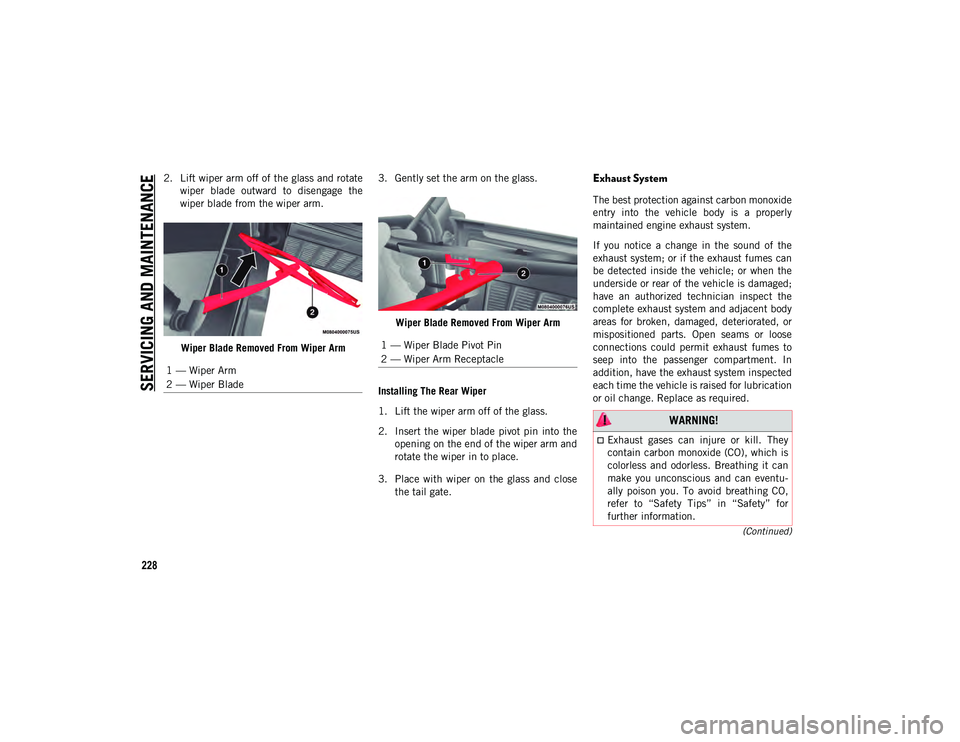
SERVICING AND MAINTENANCE
228
(Continued)
2. Lift wiper arm off of the glass and rotatewiper blade outward to disengage the
wiper blade from the wiper arm.
Wiper Blade Removed From Wiper Arm 3. Gently set the arm on the glass.
Wiper Blade Removed From Wiper Arm
Installing The Rear Wiper
1. Lift the wiper arm off of the glass.
2. Insert the wiper blade pivot pin into the opening on the end of the wiper arm and
rotate the wiper in to place.
3. Place with wiper on the glass and close the tail gate.Exhaust System
The best protection against carbon monoxide
entry into the vehicle body is a properly
maintained engine exhaust system.
If you notice a change in the sound of the
exhaust system; or if the exhaust fumes can
be detected inside the vehicle; or when the
underside or rear of the vehicle is damaged;
have an authorized technician inspect the
complete exhaust system and adjacent body
areas for broken, damaged, deteriorated, or
mispositioned parts. Open seams or loose
connections could permit exhaust fumes to
seep into the passenger compartment. In
addition, have the exhaust system inspected
each time the vehicle is raised for lubrication
or oil change. Replace as required.
1 — Wiper Arm
2 — Wiper Blade
1 — Wiper Blade Pivot Pin
2 — Wiper Arm Receptacle
WARNING!
Exhaust gases can injure or kill. They
contain carbon monoxide (CO), which is
colorless and odorless. Breathing it can
make you unconscious and can eventu
-
ally poison you. To avoid breathing CO,
refer to “Safety Tips” in “Safety” for
further information.
2020_JEEP_JL_WRANGLER_UG_RHD_UK.book Page 228